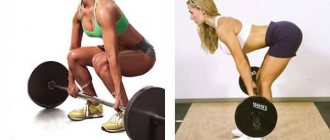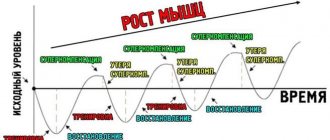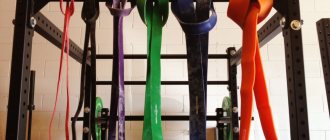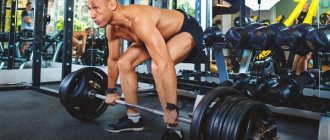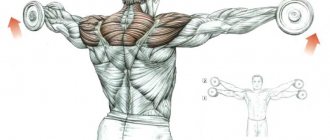Training program for 2 days a week
Amateur athletes often complain that they do not have enough time to train - long working hours, a huge number of obligations and very little time for sports and their health.
Of course, it is difficult to exercise more than twice a week in such a situation, therefore, the training program presented below for 2 days a week is designed specifically for highly busy amateurs!
If you are completely new to the gym, if there is a lot of fat in your body, then it is best to start by eliminating extra pounds, and spend several months losing weight, and then build muscle mass.
To lose weight, you need to Slightly limit your body's intake of calories from food. A special application for smartphones, MyFitnessPal, which has several tens of millions of users around the world, including in Russia, will help you with this. Its catalog contains 5 million dishes. The normal rate of weight loss is considered to be 1 kg per month, the maximum is 1 kg per week. Anything more is from the evil one.
In the future, move on to strength and mass training. To do this you need to buy a gym membership. When you start going to the gym to prepare your body for heavy physical activity, start by improving your general physical fitness (GPP). This will prepare the body for high-intensity loads and increase your performance.
Principle of progression
Of course, in order to increase traction performance, you need to constantly increase weight. Make it a rule: add 5 kg to the barbell twice a month. If adding is easy, then add 5 kg 4 times a month. Get to your maximum (when it will be almost impossible to add), and still continue to add, just less often.
You can only progress when you constantly and systematically move towards it. Always try to pull out more, but first read the next point.
Improvement of general physical fitness
To improve general physical fitness, start with cardio exercises and bodyweight exercises for strength endurance:
- Walk on a treadmill for 5 minutes
- Pull-ups 2 sets x as many as you can
- Dips 2 sets x as many as you can
- Push-ups 2 sets x as many as you can
- Jump squats 2 sets x as many as you can
- Ab crunches
- Light jogging 5 minutes
- Stretching
The entire workout should be completed in 45 minutes. Do this for 2 to 6 weeks, 2 times a week.
Next, you should study for 1-2 months according to the “Fulbadi” program (full body - the whole body in one workout). Read more about this program HERE.
What muscles work in the deadlift?
- Biceps femoris (biceps femoris) Working muscle
10 / 10 - Back extensors Working muscle
10 / 10
- Abdominal muscles Accessory muscle
6 / 10
- Quadriceps (quadriceps) Accessory muscle
5 / 10
- Back muscles Accessory muscle
4 / 10
- Biceps Accessory muscle
3 / 10
- Forearm Accessory muscle
2 / 10
The main load in the exercise is taken by the biceps femoris muscle and back extensors. Most of the remaining muscles perform holding (static) work, thanks to which our body maintains its natural position.
Two-day split
A two-day split means that all muscle groups are worked out in 2 workouts. And these 2 workouts can fit into a calendar week of 7 days, or in any other period, preferably not beyond 3-10 days. As a rule, as working weights increase, the frequency of training decreases. You can just stick to the calendar week.
The division of the training program can occur in different ways: top-bottom, bench press-traction, etc. When creating a two-day split, it is advisable to divide the muscle groups into two approximately equal parts, so that about 50% of the muscles are worked out during each workout.
Before performing exercises in each workout, you need to warm up properly! Especially if you are over 30.
Be sure to ask the trainer in the gym to show you the correct technique for doing the exercises and observe from the sidelines. Ideally, take several personal training sessions to develop your technique.
Program for men
The volume of training, measured in the number of approaches and repetitions, is quite large. Therefore, choose moderate loads (working weights). As you work through the program, pay attention to the possible occurrence of symptoms of overtraining and overexertion. If they begin to appear, then slow down, if necessary, adjust your training program by removing duplicate exercises, reducing the number of repetitions, and extend the rest period for one or two days.
Exercises for the pectoral muscles :
- Incline Bench Press 3 sets x 8 reps
- Incline Dumbbell Press 1 set x 12 reps
- Dumbbell flyes 1 set x 12 reps
Shoulder exercises:
- Standing Barbell Press 3 sets x 8 reps (watch your back)
- Wide grip barbell rows 1 set x 12 reps
Biceps exercises:
- Barbell curls 2 sets x 10 reps
- Hammer 2 sets x 12 reps
Triceps exercises:
- Close grip bench press 2 sets x 10 reps
- French press 1 set x 10 reps
Back exercises:
- Pull-ups 2 sets x as many as you can
- Bent-over barbell rows 2 sets x 8 reps
- Lat Pulldown 1 set x 12 reps
- Lat Pulldown 1 set x 12 reps
Leg exercises:
- Barbell Squats 3 sets x 8 reps
- Machine leg press 2 sets x 10 reps
- Lunges 1 set x 12 reps
Ab exercises:
- Roman chair crunches 2 sets x 15 reps
Program for girls
Exercises for the pectoral muscles :
- Bench press 2 sets x 12 reps
Back exercises:
- Deadlift 1 set x 12 reps
- Lat Pulldown 2 sets x 15 reps
- Hyperextension 1 set x 15 reps
Shoulder exercises:
- Standing Dumbbell Press 2 sets x 12 reps
Leg exercises:
- Barbell squats 2 sets x 12 reps
- Straight-legged barbell row 1 set x 15 reps
Triceps exercises:
- Dips in Gravitron 2 sets x 12 reps
Biceps exercises:
- Standing dumbbell biceps curl 2 sets x 15 reps
Ab exercises
- Hanging leg raises 2 sets x 15 reps
Class time is up to 60 minutes.
After you've been doing this training program for a couple of months, try changing it to a three-day split.
Methods for hypertrophy
mTOR activation
Every repetition counts here. Focusing on the eccentric (negative) phase of the movement and stretching the muscles under load maximizes mTor activation.
The mTor activation method is as follows:
- Lower the bar for 5 seconds, tensing the target muscles as hard as possible.
- At the point of maximum muscle stretch, pause for 2 seconds.
- Repeat 6-8 times, on the last repetition hold the position at the point of maximum muscle stretch for as long as possible. This method provides only one approach.
In action it looks like this:
https://youtu.be/GeiZKG5Bs8s
“Heavy” myo-repetitions
To maximally fatigue muscle fibers, use myo-repetitions, “invented” by Borg Fägerli. They are similar to the rest/pause method. Go to failure (or close to it) and then do (with 20-second rest breaks) as many microsets of 3 reps as you can.
When you start getting only 2 reps in micro sets, it’s time to stop. The very first set can be any number of repetitions (6-20), but for this program it is better to take a weight with which you can do 6-8.
Do as many reps as you can with that weight, rest for 20 seconds, and do 3 more reps. Rest 20 seconds and do 3 more reps. Stop when you can only do 2 reps. If you succeeded in more than 5 microsets, most likely you deceived yourself - you did not reach failure in the very first approach.
Example:
What can you achieve by exercising twice a week?
Become slimmer
A two-day training program will help solve the issue of losing weight. If you follow the correct diet, this training schedule is acceptable.
We would like to warn you that this frequency of training is not the best for losing body fat; the process of losing weight will be slow. But you can exercise for pleasure, because double training will not take much time.
Gain weight
Mass training can also be done twice a week. This is a very convenient option for those whose muscles take a long time to recover.
Typically, 36–48 hours of rest is not enough for such athletes; they need up to three days between classes. This is where 2 workouts a week helps out.
For strength exercises, this is the best option - you can rest for a long time and restore your muscles.
Keep fit
Working out in the gym 2 times a week will help keep your body in shape. This is the optimal schedule to achieve this goal.
Little time is spent, excess fat accumulates slowly or is not deposited at all (depending on proper nutrition).
Why you shouldn't exercise less often
Let's be honest. Once a week you can go skiing, walk in the park, swim in the pool, visit the bathhouse and sauna. You can do anything one-time that does not require constant maintenance and consolidation of results.
If you want to learn how to swim quickly, you need to practice more often. A lesson once a week is suitable only for relaxation and recovery. But training is not done in this mode.
Therefore, in order to achieve any of the three above goals, you need a training program 2 times a week.
To maintain muscle tone, they need to be worked out at intervals of 24–72 hours. Once a week you can only do very heavy loads, for example, deadlifts with a failure weight. But this does not mean that you cannot train your lower back and legs more during the week after deadlifting. Just the opposite - it is necessary, but with different exercises.
Keep in mind that heavy training for a particular muscle group should be done once a week. Exceptions are cases when the athlete’s muscles quickly recover and adapt to the load.
However, it is undesirable to combine deadlifts and squats on the same day, if we are talking about a two-day training.
Execution technique
Knowing what the deadlift does, you can move on to the execution technique. It plays an important role, as, in fact, in any other training. Proper execution not only helps you achieve high results, but also reduces the risk of injury. Since you are working with heavy weights here, you need to be extremely careful, otherwise there is a risk of injury.
How to take the starting position using the example of working with a barbell:
- We get close to the bar.
- Feet are shoulder-width apart, strictly parallel to each other, with toes protruding beyond the bar.
- The back is kept straight, only the shoulder blades bend. The neck should also be straight, causing the eyes to look towards the ceiling.
- The legs bend at the knees, the back remains straight.
- We clasp the bar with our hands, placing them slightly wider than shoulder width.
Direct weight lifting:
- Before lifting the barbell, the athlete takes a deep breath.
- At the moment of exhalation, you need to lift the barbell, feeling how the torso and legs take a straight position.
- The lowering process should be exactly the same, with the bar remaining parallel to the floor. The back is flat, the shoulder blades are brought together.
- Only when the bar has crossed the level of the knees can you begin to squat, at this moment the pancakes already touch the floor.
Speaking about specific numbers, one approach can include from 4 to 6 repetitions. However, only subject to correct execution and good health of the athlete.
Proper deadlift technique is very important. It ensures results and human safety, so the following mistakes should never be made:
- rounding of the back is an incorrect position of the spine, which can cause harm to health;
- move sharply and quickly - when working with weights, exercises are performed smoothly and gradually, otherwise there is a risk of muscle rupture.
If you can't keep your back straight, then reduce the weight you're working with. If you have just started exercising, use only dumbbells. If such a deadlift is chosen, the execution technique remains identical; in addition, it will be easier to do, since the load will be distributed evenly on both sides.
Training programs
Each goal will make its own adjustments to the program. Two workouts per week should be intensive to cover all muscle groups. At the same time, you need to try to think through the training schedule so as not to increase the duration of a one-time visit to the gym.
The preparation of the program should be carried out by an experienced athlete who is familiar with anatomy and physiology, as well as a perfect understanding of the technique of performing most exercises.
Let us remind you that for training twice a week, the program should be optimally capacious. We will show you with specific examples how to use this feature of a two-day training.
Weight loss program
A set of exercises for losing weight will look like this:
- Cardio - 15-20 minutes at an average pace, at the end (last 3-4 minutes) perform one interval (maximum acceleration for 20-30 seconds). Then restore the rhythm and breathing for 2-3 minutes, only then stop completely.
- Leg press in the simulator - 3 sets of 15 times with light weight. You should feel the heaviness, but also have a reserve of strength for 15 or more repetitions. We do it quickly.
- Hyperextension - 2 sets of 20 times.
- Lunges with dumbbells - 3 sets of 15 times (should be hard, but with a reserve of strength).
- Dumbbell flyes lying on a horizontal bench - 3 x 15 times.
- Bending arms with dumbbells while standing with supination - 2 x 15 times.
- Seated dumbbell press - 2 x 20 reps with light weight.
- Circuit training for the abs: 10 crunches on the mat; 10 hanging leg raises; 10 crunches on a Turkish chair; 10 leg raises from a lying position. On the last lift in the last exercise, we freeze in the “legs above the floor” position and hold it for 30 seconds. Rest for 60 seconds and repeat the abdominal circuit. We do 2-3 circles.
Between sets of other exercises you need to rest no more than 60 seconds, keep an eye on the time. Finish the workout with a small stretch of the large muscles (lower back, legs).
- Cardio - 20 minutes at an average pace, at the end speeding up for 2-3 minutes, but not to the maximum. Accelerate to 13–16 km/h and maintain this speed for 2–3 minutes.
- Leg extension in the simulator - 2 sets of 15 times, do the third approach until the muscles burn. When this feeling comes, do another 10 repetitions.
- Romanian or deadlift - 3 sets of 15 reps with a barbell or dumbbells.
- Plie squats (for girls) or leg press (for men) - 2 x 20 times.
- Hammer chest press or dumbbell bench press - 3 sets of 15 reps.
- Crossover in a block exercise machine on the lower chest.
- Extension of the arms on a block in a superset with curling the arms with a barbell or dumbbells (small weights) - 3 sets of each exercise in 15 repetitions.
- The final cardio workout is 10-15 minutes at a slow pace. Your task is to sweat, stretch tense muscles and prepare your body for a shower.
Limit yourself in calories, don't eat at night, less carbohydrates, more protein.
https://youtu.be/PC7pPGLnoOc
Mass gain program
A training program for gaining muscle mass is more suitable for men. Women without exogenous testosterone will have difficulty gaining muscle:
- Cardio - 5-7 minutes. The task is to bring the heart to 140 beats per minute, gradually reduce the rhythm to 90-100 beats per minute.
- Hyperextension - 2 to 15.
- Leg press or deadlift (the first week we do the press, the second week we do the deadlift).
- Bench press - 5 sets of 5-6 reps each. Weights - refusal.
- Hammer press or 30 degree angle press (alternate every week).
- Seated barbell press or hammer shoulder work.
- Barbell curls for biceps - 3 to 8.
- Raising legs from dumbbells while hanging onto the abs (legs bent at the knees) - 3 sets of 8-10 reps until failure.
- Stretching on the mat.
- Cardio - 5-7 minutes according to the plan for the first day.
- Squats with a barbell - 5 5-6 times.
- Leg press - 3 x 8-10 times.
- Bench press - 5 5-6 times.
- Extension of arms in a block simulator like a ladder - 12 times, 10, 8, 6, 4 (maximum weights).
- Rows of the upper block to the chest with a narrow grip - 3 8-10 times.
- T-bar row - 3 sets of 6-8 reps.
- Hammer curls with dumbbells while standing – 3 x 10 times.
A training program for gaining muscle mass should be optimized in such a way that you give your best. It is necessary that all your muscle groups receive a failure load.
A load after which you are no longer able to lift the working weight even once during training is considered a failure. This weight is not easy to determine. Personal experience and your own feelings will help you.
For example, if you did 8 repetitions in the first approach, and in the second you already threw the barbell at 5 or 6, the weight is too much for you. On the contrary, if after 8 repetitions you feel that you will do 2-3 more repetitions, the weight is light. Through trial and error you will find the best option for yourself.
Fitness program
You don't have to go to the gym for a great purpose. You can simply keep yourself in good shape:
- Cardio - 10 minutes at a moderate pace.
- Barbell squats - 3 sets of 10 reps with a comfortable weight.
- Hyperextension - 3 x 15 times.
- Leg bending and extension in a superset machine - 2 sets of 10 repetitions for each exercise.
- Pull-ups - 3 N times, where N is as many times as you can perform using pure technique.
- Bending and extension of arms with dumbbells in a superset - 2 sets of 10 repetitions for each.
- Hanging leg raises - 3 x 12 times.
- Stretching.
- Cardio - 10 minutes at a moderate pace.
- Bench press - 3 x 10 times.
- Raising arms with dumbbells at an angle of 30 degrees - 3 x 10 times.
- Leg press - 3 x 10 reps with heavy weight.
- Bent-over barbell row to the lower back.
- Hyperextension - 3 to 15.
- Roman chair crunches – 3 x 12–15 times.
- Stretching.
Speed deadlift variation
To increase your deadlift results, you must perform explosive deadlift variations from time to time. In principle, everything is simple: we do the same classic deadlift, only we do it specifically with light weight, many repetitions and quickly. What is called explosive style.
For the speed version of the deadlift, we take 40-60% of the working weight and perform deadlifts in an explosive style. Fast and a lot. In this case, you need to take into account the fact that speed should not affect quality. The technique should still be perfect and the bar should not bounce off the floor.
What else to do
CrossFit can be practiced twice a week - this is the optimal regime. On the first day of training, for example, you hit your legs and shoulders. And in the second - arms, back and chest.
Let us remind you that in CrossFit the training is circular, and the intensity is more suitable for burning fat. In addition, there are many contraindications for this type of fitness.
To improve your running performance, it makes sense to practice this amount of running. You can jog for 30–40 minutes, alternating intense short-term running with jogging (in other words, interval running).
How to build muscle and become stronger by training 2 times a week
To become strong and build muscle, you don't have to exercise often. Let's consider the option of low-volume, high-intensity training.
In recent years, I have often come across the opinion that strength training in the gym should be frequent. It would seem, why not? After all, quantity develops into quality?
Of course, basic exercises like squats, deadlifts, and bench presses can be performed frequently, and many do. Many have tried wave periodization of loads by day, when the same high-intensity exercises are performed 2-4 times a week, or even more often. Some saw good results and rushed to praise this approach online. But they soon found themselves at a dead end.
Why? Because for powerlifters it is often important to force themselves to slow down, not the other way around.
This prompted me to develop programs with reduced volume and frequency, conducting 3 workouts per week, alternating loads on the upper and lower body. Also, I suggest not performing back squats and deadlifts in the same week.
Yes, yes, that's not a typo. Let's figure it out.
Russian Influence
I will not flood this article with links to 20-week studies conducted on college students. I will simply refer to a recent study with a suitable design, according to which wave periodization by days has no advantage over classical linear periodization.
The effectiveness of a training program depends to a great extent on how much the athlete commits to it and how much it matches his spirit. This cannot be calculated in the laboratory. The variables that make a program effective are often intangible; they lie in the personality of the practitioner.
At one time I made training progress by doing small amounts of high-intensity work. It was in my spirit.
When I started powerlifting, I heard that this approach wouldn't work, that you had to lift heavy weights often. Large volumes, many times a week. This vision was based on the programs used by Russian powerlifters.
Well, I tried it out. And I hated it. It didn't resonate with me and I disliked the training.
I was struggling with how to create a training program that could combine my love of low volume with high intensity. At least just for powerlifting. I read a lot, but did not find anything that would give me faith.
Finally, I put aside reading and did what I should have done a long time ago - I learned everything on my own.
Deadlift problem areas
In order to increase your performance in the classic deadlift, you need to work on problem areas (I hope it’s clear that I’m not talking about cellulite on the ass or fat on the sides
). This means working on problem areas that may prevent you from reaching a new level in deadlifting. These places are different for everyone, and they depend on a whole bunch of different factors:
- on body type;
- on the level of training;
- on the ratio of muscle pumping.
Therefore, in order to improve your results, you need to work on these most problematic areas. We empirically determine which phase of the lift is more difficult and eliminate these problem areas using the following recommendations:
The problem is the starting position
If the most difficult thing is to lift the barbell off the floor, then you need to work on this place. In the lower part, most of the load falls on the gluteal muscles. It is clear that at this moment you need to work on strengthening the gluteal muscles + working on the lower (starting) phase of the movement.
To work the lower part of the movement, it is best to perform deadlifts from an elevated position. To do this, put a pancake on the floor (two are possible), stand on it and perform the classics. There is no need to climb onto parapets or stands that are too high (25–40 cm); a starting position that is too high will put excessive stress on the lower back at the moment of takeoff, and this is dangerous. 5–10 centimeters will be enough. The weight in this case is 80–90% of the working weight.
There are also options for traction to the knees or statics. When rowing to the knees, we load the barbell with 10% more weight than our working weight, and do only the lower part of the amplitude, i.e., we work on lifting and moving the barbell from the floor to the knees. We perform statics with a weight 15–25% less than the working one, bring the bar slightly lower than to the knees and stay in this position for the maximum possible time.
Both when performing the lower part of the deadlift, and when performing statics, you need to monitor the technique as accurately as possible. As soon as the technique begins to break down in any way, in the first case you need to stop the exercise or lose weight, in the second case you need to immediately lower the barbell to the floor. Health is more valuable than the intermediate result!
Problem when passing knees
As you pass the knees in a classic deadlift, you simultaneously extend your legs and straighten your back. And if the back extensor muscles (also known as the lumbar muscles) do not have sufficient strength, then this moment can be difficult and create obstacles on the way to new personal records in the deadlift. In addition, the lumbar spine is most at risk when performing deadlifts, so the back extensor muscles need to be strengthened anyway.
The best ones for this are:
- hyperextension;
- standing on straight legs;
- “good morning” exercise (bending over with a barbell on your shoulders);
- deadlifting from high racks or plinths.
Squats and Deadlifts Every Week
When I developed my technique, the Internet was still in its infancy. This is one of the reasons I couldn't find enough information on how to develop strength abilities without the volume and frequency used in most programs.
But I did know that squats and deadlifts work the muscles in the back of the body, and if you spread these exercises over different weeks, then although the same muscle groups would be worked each week, a significant portion of the load would fall on different areas - e.g. knee extensors or chest extensors.
Of course, the quadriceps are active during the deadlift, but the knee extension is minimal. This means, I reasoned, that on the days of performing deadlifts it is necessary to place additional load on the leg muscles. But I wanted to make sure that this load would not overload the back muscles: many powerlifters do not know that erectors recover very slowly, and it is this under-recovery that most often slows down progress.
In other words, squats and deadlifts are usually sufficient to stimulate growth in the size and strength of the erectors of the back. Additionally, all you need is quality rest. After conscientiously doing leg presses and shin curls in the machine, torturing yourself with repeated hyperextensions and good mornings is unnecessary and, in general, useless.
How to increase your deadlift
I hope it is clear that now we are talking about how to increase the classic deadlift. The classic deadlift is in fact one of the golden three exercises of bodybuilding, and besides, it is the basis of powerlifting and weightlifting. What can I say, separate competitions have been held among lifters for a long time specifically in deadlifting as a separate discipline of powerlifting.
For us, natural bodybuilders (especially amateurs who lift “for themselves”), on the one hand, it seems like we don’t really need to lift exorbitant weights in the deadlift. On the other hand, you still need to know how to improve and increase your deadlift performance.
I will not re-list all the advantages that the classic deadlift brings; I have already done this in detail here. It’s better to get down to business and finally find out how you can increase your results in deadlift.
Auxiliary Exercises
How can you ensure that squats and deadlifts fully engage the target muscle groups? Obviously, it is wise to combine them with additional exercises.
As for complementing the deadlift, I personally settled on the leg press, since it is a good load on the quadriceps, and, due to the truncated range of motion, it is gentle on the lower back. At the same time, the amplitude is still close to full, which means that you do not need to load the machine with all the weights in the gym in order to achieve muscle fatigue.
In my experience, the leg press is also an exercise that helps you learn to push off the floor. After all, many do not understand that performing a deadlift means not just pulling the barbell, but pushing off from the support and moving the weight above the knee line.
Regarding squats, I wanted to make sure that on the days when they were performed, the load still fell on the back muscles, which performed the lion's share of the work when performing deadlifts.
And I chose the bent over row. In a sense, this is a lighter version of the deadlift: the lower back also works in an isometric mode, holding the body. In addition, I would recommend periodically supplementing squats with rows of a vertical block to the chest. And on deadlift days, after leg presses, sometimes do another “exhaustive” set of squats in the hack squat machine. Such additions gave me a feeling of completeness of the training.
Fight the weakest links in your deadlift
To increase your deadlift, it’s not enough to just do it alone. The fact is that doing deadlifts alone will not lead to pumping up all the muscles necessary to increase performance in the classics.
The deadlift uses about 80% of the muscles of the body, but we directly influence all these muscles in different ways by performing the classics. That is why, in order to improve your results in the deadlift, you need to pump up all the auxiliary muscles. In fact, this is the main emphasis of today’s publication.
Stop Worrying, Just Get Stronger
It may seem ridiculous to some to exercise twice a week, but you need to keep in mind that these are hard workouts, clearly not suitable for those who have been training for less than a year.
Since I started training with this program, I have met many successful, like-minded people. Among them is the Lillibridge family, probably the strongest family in powerlifting. Jim Wendler, the creator of the cult “5/3/1” program, adapted his training to a similar technique and got excellent results.
I can say this is one of the most productive techniques I have ever used. She gave me motivation and a feeling of reboot. I broke my own records almost every week, I didn’t feel squeezed, I wasn’t plagued by injuries. Finally, not only did I work for the program, but it also worked for me.
So, if you just like to spend more time in the gym, fine. But if you like the idea of reducing the frequency and volume of training, then go ahead. I think you will be pleased with the results.
Warm up
Before you load yourself up with quick sets of 2-3 reps with a weight that is 50-70% of your maximum, you should warm up. Most guys don't do this, which is a step towards problems. When you warm up properly, you not only reduce your risk of injury, but you also improve your performance! I think you'll agree that this is a worthwhile use of your time.
Assuming your max is 400 pounds, here's what a good workout might look like, including warm-up sets:
- 135 lbs (61.23 kg) x 5 reps x 2 sets (warm-up)
- 185 lbs (83.91 kg) x 3 reps x 2 sets (warm-up)
- 200 lbs (90.72 kg) x 2 reps x 2 sets (working sets)
- 225 lbs (102.1 kg) x 2 reps x 2 sets (working sets)
- 245 lbs (111.1 kg) x 2 reps x 2 sets (working sets)
- 260 lbs (117.9 kg) x 2 reps x 1 set (working sets)
- 280 lbs (127 kg) x 2 reps x 1 set (working sets)
Remember, you should perform each repetition as dynamically as possible without losing quality.
Mass training program 2 times a week
Often, bodybuilding enthusiasts simply do not have enough time to train three times a day, let alone four classes throughout the week. Of course, by training three times you can achieve better results. However, if you really have a problem with free time, then do weight training 2 times a week.
If you have not previously engaged in sports and there is a large amount of fat in your body, then you should first get rid of it. In a few months you should cope with excess weight and after that you can start working on mass. To lose weight, you first need to reduce the caloric content of your diet.
There are a large number of different calculators on the Internet for calculating the energy value of the diet. You can also use special applications for smartphones. You should also remember that you need to lose weight at a certain speed, namely, get rid of a maximum of one kilo of weight over the course of a week. This ensures that you only lose fat and maintain muscle mass.
How to effectively gain muscle mass?
When you start visiting the gym, you first need to pay attention to general physical fitness. You should not immediately actively load your body, as this can negatively affect your health. Of course, this recommendation applies only to those people who have not previously played sports.
To begin with, you should use cardio exercises and work with your body weight. Here is a sample lesson plan to improve your physical fitness:
- Walking on a treadmill - duration is 5 minutes.
Pull-ups - 2 sets with maximum repetitions.
Dips - 2 sets with maximum reps.
Classic push-ups - 2 sets with maximum repetitions.
Squats followed by jumps - 2 sets with maximum repetitions.
Crunches - 2 sets with maximum repetitions.
Easy jogging - duration 5 minutes.
- Exercises for stretching muscles.
To complete this set of exercises you will need to spend about 45 minutes. Do weight training 2 times a week. The duration of such classes depends on your initial level of training and can range from two weeks to one and a half months.
After this, you need to switch to using the “fulbadi” system, or, more simply, train all muscle groups in each lesson. Train like this for one or two months. After this, you can switch to a split system.
Training program 2 times a week
The split system involves dividing all the muscle groups of the body into a certain number and then training them on a certain day. In our case, a two-day split will be used and you will have to work all the muscles in two days.
There can be many principles for dividing training. For example, you can perform pressing movements on one day, and pulling movements on the second. Or you can use the “top-down” principle, doing mass training 2 times a week and alternately working on the upper and lower parts of the body. Let us remind you that first you should master the technique of all exercises and for this you can hire an instructor who is in any gym.
Let's get acquainted with the training program for men, and then consider the features of training for girls.
1st day of training
Bench presses while lying on an incline bench - 3 sets of 8 repetitions each.
Dumbbell presses while lying on an incline bench - 1 set of 12 repetitions each.
Dumbbell flyes - 1 set of 12 repetitions each.
Standing barbell presses - 3 sets of 8 repetitions each.
Rows of the barbell in the direction of the chin, wide grip - 1 set of 12 repetitions each.
Hammers - 2 sets of 12 repetitions each.
Bench presses, close grip - 2 sets of 10 repetitions each.
- French presses - 1 set of 10 repetitions each.
2nd day of training
- Pull-ups - 2 sets with maximum repetitions.
Bent-over barbell rows - 2 sets of 8 reps each.
Lat rows - 1 set of 12 reps each.
Lower block rows towards the waist - 1 set of 12 repetitions each.
Squats - 3 sets of 8 repetitions each.
Leg presses - 2 sets of 10 repetitions each.
Lunges - 1 set of 12 repetitions each.
- Roman chair crunches - 2 sets of 15 repetitions each.
Features of weight gain in girls
Today, girls also actively visit the gyms, and we simply have to tell you about weight training 2 times a week for women. One of the main differences between the female body and the male body is the high activity in gaining fat mass. Girls can gain fat much faster than men. As a result, they have to use strict diet programs and exercise. Let's find out what factors have the maximum impact on the accumulation of fat in the female body.
Hormone concentration.
- The human physique is mainly formed by two hormones - norepinephrine and testosterone. At the same time, these substances have a strong effect on the nervous system. Since testosterone is the most important hormone in the male body, and norepinephrine is synthesized in large quantities, guys can work during failure training. This guarantees muscle growth. Girls are not capable of training like that. Since the concentration of the above mentioned hormones is low.
Number of muscle fibers.
The muscle fibers of men are able to contract much more often than women. Thus, girls performing 6 to 8 repetitions per set is not effective for gaining mass.
Muscle distribution.
In the male body, muscles are distributed evenly, but in women there is a disproportion in this regard. The strongest muscles in women are in the right part of the body, but the upper one lags significantly behind.
- Metabolism.
The rate of metabolic processes in the female body is significantly lower compared to men. Consequently, every kilo of a woman's body consumes less energy. While men can eat a lot of food without gaining weight, this is unacceptable for women. The metabolic rate is influenced by the amount of muscle mass, because to maintain muscles it is necessary to expend energy even at rest.
Girls should also remember that they should not consume carbohydrates in the evening. Since the metabolism in the female body is low, the likelihood of converting carbohydrates into fat reserves is higher. At the same time, the female body can begin to use fat tissue for energy much faster. This is primarily necessary during pregnancy.
In a woman’s body, these processes are activated already at a heart rate of 110 to 120 ulars per minute. In this case, a cardio session should last at least half an hour, and preferably 60 minutes. To lose weight under the influence of cardio exercise, you must adhere to exactly this pace of work during the lesson. It is to eliminate excess weight that most girls go in for sports. If we talk about the motivation of girls, then first of all it is, of course, their figure. At the same time, cardio can be most effective for weight loss when combined with strength training, but many girls are completely unreasonably afraid to lift weights.
https://youtu.be/peMwg4Ko_ts

